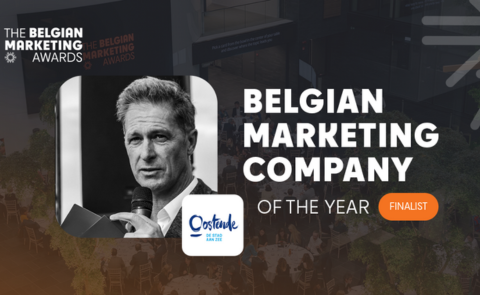
21 Oct Belgian Marketing Awards – Belgian Marketing Company of the Year: Toerisme Oostende
Will this year’s award for Belgian Marketing Company of the Year go to ‘het zeitje’? Toerisme Oostende is one of the three nominees with a remarkable case, for which the foundations were laid almost thirty years ago. We asked Peter Craeymeersch, General Manager of Tourism Ostend, about the secrets behind the transformation of the queen of seaside resorts.

In the mid-1990s, Ostend was at a crossroads. The city was struggling with outdated infrastructure, a heavy reliance on summer visitors and hotels that were not filling their rooms. Nearly three decades later, Ostend has grown into a thriving, vibrant and cultural destination that is on the map as a place worth visiting year-round.
Rebuilding a city
“The situation in 1995 was less positive,” says Peter Craeymeersch, who started work in Ostend in 1997. “Ostend was mainly focused on summer activities. A quality study indicated that the quality of our hotels was insufficient and the city had a polluted image. Moreover, we were hugely dependent on the weather, which made our tourism vulnerable.” To turn the tide, the city set up an investment plan for public spaces, but it realized from the beginning that mere physical investments would not suffice. “We knew that a flanking narrative was needed to support the investments and create a positive image for the city,” he explains.
When Peter Craeymeersch tells the story of the transformation, it is striking how strongly he emphasizes the economic vision behind Ostend’s successful city marketing. For example, the investment plan gained support through a public-private partnership between local authorities, hotels, restaurants and the private sector. He illustrates its usefulness with a concrete example. “At the beginning of this century, we established that British tourists accounted for 25% of our overnight stays. However, the British market was volatile, depending on the pound exchange rate and the economic situation. We therefore took the decision to focus on Belgian, German, French and Dutch tourists. That caused a few difficult years and a clean-up of the hotel sector, but after a few years we had hotels that were able to start investing because average room rates were higher thanks to the new market focus. That’s a change you can only implement from a good public-private partnership and on which you can then also build coherent marketing.”
The selection committee that held up the case of Tourism Ostend also hammered the same nail. “The transformation is the result of 25 years of consistent work on the city and its tourism image, with a clear DNA definition from the start,” said Dirk Vandekerckhove on behalf of the committee. “On this basis, Tourism Ostend made clear long-term choices. It pioneered such a tourism vision in our country, which moreover grew from a public-private partnership. It was far-sighted to approach it this way at the end of the last century.”
Qualitative event marketing
Central to Ostend’s city marketing is a long list of quality, unique events that have put the city on the map. From Theater aan Zee and Oostende voor Anker over the Ostend Film Festival to the DS Podcast Festival, FAAR or Ensor2024. In doing so, it targets organizations where the city and the event reinforce each other. “We want the city and the event to interact in a full-fledged way. I always say: there have to be barbs on the event. It has to be an event that you can’t just put in another city.” Translated into strategic terms, Tourism Ostend tests each event for economic return, marketing power (the match with the city) and quality of organization. “That is our value meter and we find that the events we choose not only strengthen the city’s image, but also attract repeat visitors.” With increasingly smart technology, Tourism Ostend is also analyzing visitor data and flows to increase the impact of events. “If it turns out that a shopping street experiences little added value from an event, we look at how we can optimize that through a special route during a subsequent edition, for example,” says Peter Craeymeersch.
Between Arno and the Thermae Palace
Tourism Ostend’s approach clearly paid off. Since 2007, the number of tourists increased by 51%, the number of four-star hotels grew and the number of second-stayers increased sharply. Not unimportantly, certainly in recent years the city has gained a reputation as a cultural hotspot, including BVs testifying about their deliberate move to the coastal city. “We were actually doing influencer marketing even before it was really a thing,” says Peter Craeymeersch. “People like Marcel Vanthilt and Martin Heylen were already testifying about their love for Ostend ten years ago, but the biggest match we had was with Arno, even though he lived in Brussels. Artistic, free-spirited, authentic … he had everything that Ostend stands for.” However, the positive evolution of the image does not take away from the fact that Ostend also faces challenges. The lingering renovation of the Thermae Palace or trash on the beaches after busy summer days provided just as much of a dose of negative publicity. “The one thing you cannot do in such cases is to ignore the problems. If, like this summer, a 17-year-old drowns in Ostend, it stays on my mind. Then we launch campaigns, including with the NMBS, to make it clear that the sea is not a stagnant bath. Ditto for a problem like the pollution of the beaches.”
Tourism Ostend has invariably kept a long-term perspective in mind over the past thirty years, and even now Peter Craeymeersch does not hesitate to look further ahead. He wants to respond to changing demographics, which are aging the coast, and to the Blue Economy. “Ostend can link climate-conscious stories with a future-oriented economy. And the big advantage is: when people come here, they have time and make time to absorb those stories.”
Wondering how the judges assessed this case… The answer will follow on Nov. 6….
Register now for the ceremony of the Belgian Marketing Awards >
